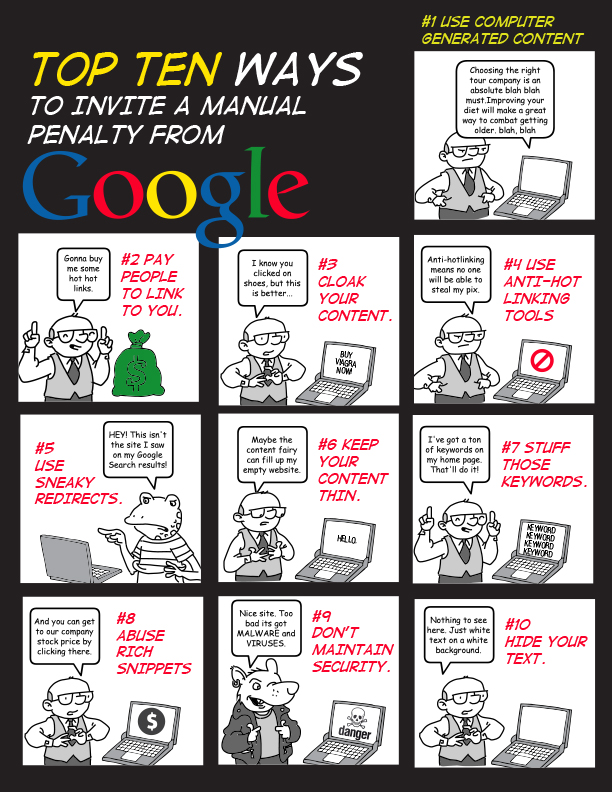![By Juliancolton (Own work) [Public domain], via Wikimedia Commons](https://didit.com/wp-content/uploads/2014/11/1024px-Closeup_of_pencil_graphite.jpg)
November 12, 2013: Remember being called into the principal’s office in Middle School? Well, getting a Google “Manual Penalty” notification from Google is much worse — it’s the online equivalent of finding a notice from the local sheriff tacked to your door. If you don’t address it in a timely fashion, you may see your rankings, traffic, and overall search engine visibility drop to zero. Even if you do address it by asking for and receiving a Reconsideration Request, your rankings may not recover for a long time, so the idea is to avoid getting a Manual Penalty in the first place.
Are you doing any of the following things? Don’t, because such activities invite a Manual Penalty from Google:
1. Use Computer-Generated Content
Miserly online marketers unwilling to pay real human writers to create original content have been using many hat tricks over the years to crank out content that will get through Google’s Duplicate Content Filter. One easy trick is to translate a given passage of text into a foreign language, say German, and then retranslate the text back into English. Yes, it’s probably different enough for the Duplicate Content, Google is capable of detecting — and penalizing — this type of programmatic manipulation. There are many other ways of generating content through automated processes. Avoid the temptation to use any of them.
2. Pay People To Link To You
Paying people to link back to you — or offering any other kind of tangible consideration — directly attacks the core of Google’s PageRank system. Even if you keep this practice “on the down low,” it’s risky, and there have been many sad stories on Google’s Webmaster forums about site proprietors whose traffic evaporated when their paid link schemes were discovered. Remember, Google doesn’t just use algorithms to detect spam, but also an army of humans who can sniff out sites with sketchy business models.
3. Cloak Your Content
Cloaking is the online equivalent of “bait and switch” and has been used by bottom-feeding webmasters to trick humans into clicking on a SERP listing. When the searcher arrives, however, he/she sees something completely different. Cloaking is such an obvious no-no that it’s seldom used today. Sometimes unwary but innocent webmasters see a “cloaking” penalty warning when they’ve been hacked — if you see this warning, you have a critical issue that you need to address — now.
4. Use Anti-Hotlinking Tools
Anti-hotlinking tools may make sense for webmasters who don’t want 3rd parties to embed their images on external sites. Unfortunately, if Google detects them in use, it may issue you a Manual Penalty called “Image Mismatch,” a form of cloaking that is a violation of its guidelines. If 3rd parties are replicating your images without your consent, the best thing to do is to file a DMCA complaint through Google.
5. Use Sneaky Redirects
Redirects (which route a user from one URL to another) have a legitimate use, but if Google thinks that the purpose of using any redirect is to present pages that are different from those listed on its SERPs, you’re in big trouble, because Google sees this as a form of cloaking.
6. Keep Your Content Thin
Content-scraping (the practice of gathering content from sites that do not belong to you) is one easy, but perilous way to create content for your site. Using the content from RSS feeds to populate pages is another. Unless Google – either algorithmically or through a human reviewer – concludes that you’re actually adding value, you may receive a “thin affiliate” manual penalty.
7. Stuff Those Keywords
If you’re trying to rank for certain keyword combinations by loading up your articles with these same keywords, you’re approaching content generation in exactly the wrong way. Don’t repeat keywords, and don’t even think about them when you’re writing – the theme – not the keyword content – of articles is what Google’s looking for, and its latest algorithm tweak, code-named Hummingbird, is tuned to detect such themes, whether or not keywords are actually used in the text.
8. Abuse Rich Snippets
Rich Snippets let commercial webmasters highlight product or service details directly on the SERP. If Google has any reason to believe that any of the information in these snippets is false or misleading (for example, phony reviews), your visibility on Google will be snipped. Also, don’t take information that belongs in one category (say, a promotional text string) and try to plop into a different category (say, “Events”). This is both confusing to searchers and penalty-worthy.
9. Don’t Maintain Security
If Google believes that your site has been hacked, it will immediately take action to spare its searchers against any malware that might now exist on it. Recovering from a hacking attack is beyond the scope of this article, but Google has some helpful recovery information available online.
10. Hide Your Text
Hiding text on your pages designed to attract searchers (often implemented by using the same font color as the background or by setting font size to “0”) is a very old deception tactic, and so it’s rarely used today. Still, Google lists it as a penalty-worthy tactic, so unless you’re a glutton for punishment, please don’t do this.
Hopefully, you’re doing none of these things. But it’s a good idea to check Google Webmaster Tools from time to time to make sure that you remain in Google’s good graces.
Here is a quick “cheat sheet” to the 10 ways listed above…

- 10 Mistakes to Avoid When Using QR Codes for Marketing - September 20, 2023
- Kevin Lee on How AI Changes the SEO Landscape - August 31, 2023
- The Power of Compound Marketing: Kevin Lee Presents @ 1MediaWorld 2023 Global Conference - March 7, 2023
